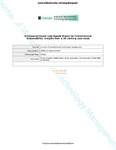Developing Closed Loop Supply Chains for Environmental Sustainability: Insights from a UK clothing case study
| dc.contributor.author | Ashby, AL | en |
| dc.date.accessioned | 2018-02-28T08:49:57Z | |
| dc.date.available | 2018-02-28T08:49:57Z | |
| dc.date.issued | 2018-06-04 | en |
| dc.identifier.issn | 1741-038X | en |
| dc.identifier.uri | http://hdl.handle.net/10026.1/10898 | |
| dc.description.abstract |
Forward and reverse supply chains form a ‘closed loop’ when managed in a coordinated way and this ‘cradle to cradle’ responsibility has strong relevance to addressing environmental sustainability in global supply chains. The extensive outsourcing of manufacturing has created highly fragmented supply chains, which is strongly evidenced within the UK clothing industry, and it presents major environmental challenges, particularly around waste and resource use. The paper investigates how a Closed Loop Supply Chain (CLSC) can be successfully developed to address environmental sustainability. The Natural Resource Based View (NRBV) acknowledges the importance of a firm’s tangible and intangible resources, as well as socially complex relationships, and provides 3 path dependent strategies for achieving environmentally-based competitive advantage. Via an in-depth case study of a UK-based clothing firm the NRBV is employed as a framework for understanding the processes that a focal firm needs to engage in to develop a CLSC, and the contribution that is made by its resources and supplier relationships. The findings illustrate the key importance of strategic resources and shared vision and principles between the focal firm and its suppliers, in order to progress from a more reactive pollution prevention strategy to a fully embedded CLSC response to environmental sustainability. The case study highlights the need to extend the current CSLS model to integrate the design function and end customer; the design function ensures that appropriate environmental practices can be implemented, and customers represent a key stakeholder as they enable the reverse flows required to maximise value and minimise waste. The NRBV and its 3 path-dependent strategies is an established framework for understanding environmentally-based competitive advantage, but has not previously been employed to investigate CLSCs. This research therefore provides valuable insight into the applicability of this model in the supply chain field, and the key role of tangible and intangible resources and socially complex supplier relationships in developing and achieving a CLSC. | en |
| dc.language.iso | en | en |
| dc.publisher | Emerald | en |
| dc.title | Developing Closed Loop Supply Chains for Environmental Sustainability: Insights from a UK clothing case study | en |
| dc.type | Journal Article | |
| plymouth.journal | Journal of Manufacturing Technology Management | en |
| dc.identifier.doi | 10.1108/JMTM-12-2016-0175 | en |
| plymouth.organisational-group | /Plymouth | |
| plymouth.organisational-group | /Plymouth/REF 2021 Researchers by UoA | |
| plymouth.organisational-group | /Plymouth/REF 2021 Researchers by UoA/UoA17 Business and Management Studies | |
| plymouth.organisational-group | /Plymouth/Research Groups | |
| plymouth.organisational-group | /Plymouth/Research Groups/Institute of Health and Community | |
| dcterms.dateAccepted | 2018-02-08 | en |
| dc.rights.embargoperiod | Not known | en |
| rioxxterms.version | AM | en |
| rioxxterms.versionofrecord | 10.1108/JMTM-12-2016-0175 | en |
| rioxxterms.licenseref.uri | http://www.rioxx.net/licenses/all-rights-reserved | en |
| rioxxterms.licenseref.startdate | 2018-06-04 | en |
| rioxxterms.type | Journal Article/Review | en |


